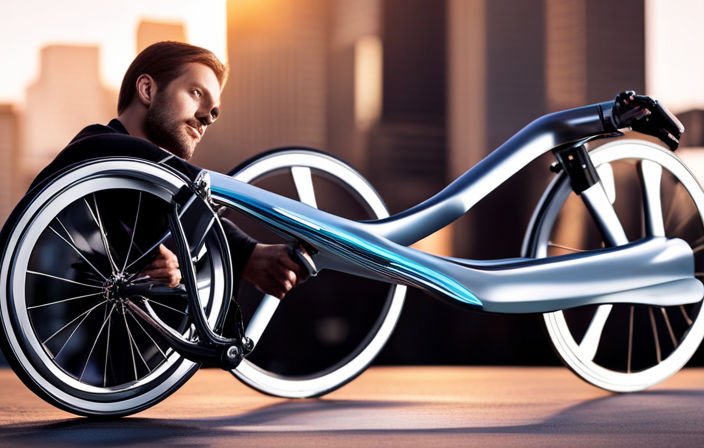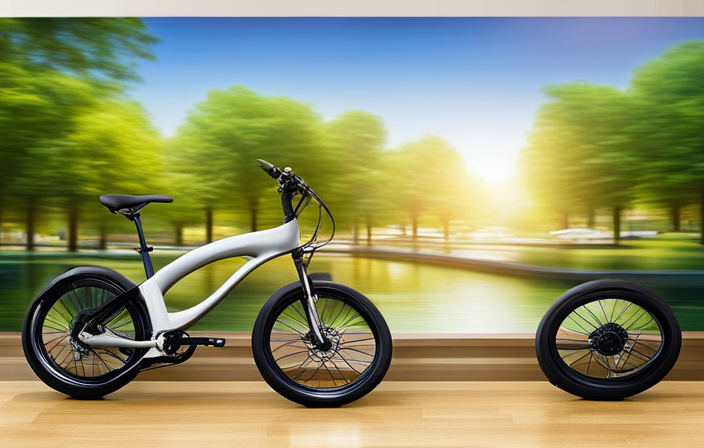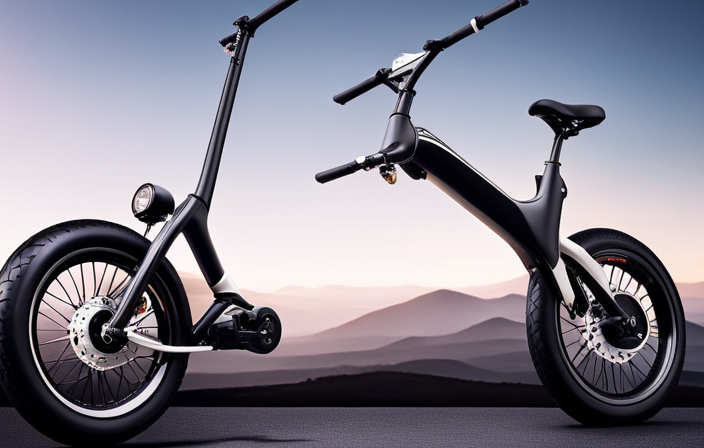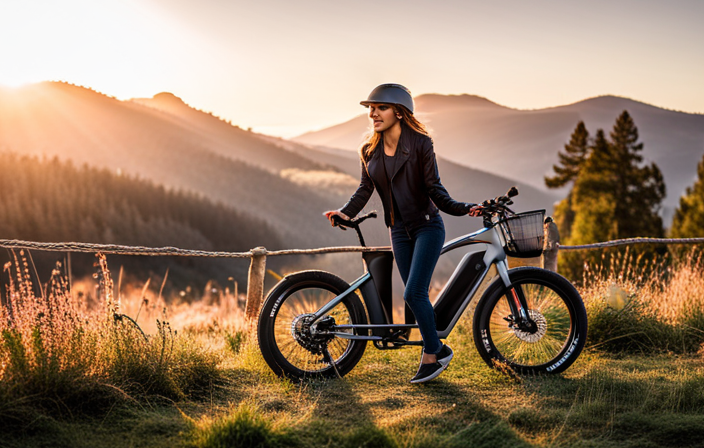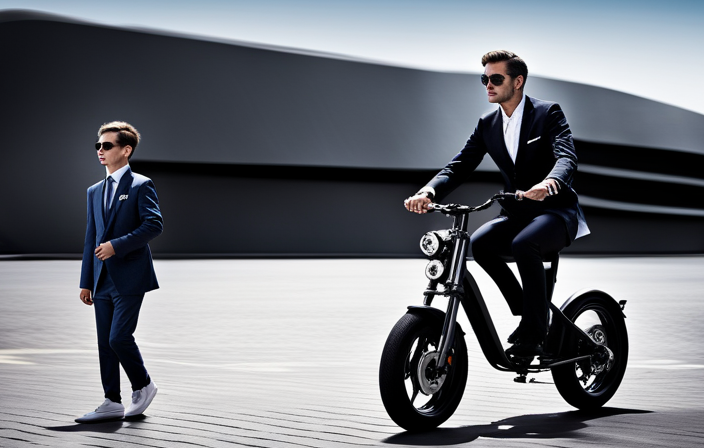Did you know that electric bikes are rapidly gaining popularity, with sales increasing by 91% in the past year?
If you’re looking to join the electric bike revolution but don’t want to invest in a new bike, converting your normal bike to electric is a great option.
In this article, I will guide you through the step-by-step process of converting your bike into an electric one. From assessing compatibility to installing the motor and battery, I will provide you with all the technical details and information you need to successfully complete this conversion.
Let’s get started!
Key Takeaways
- Enhancement of riding experience through conversion
- Environmental and economic advantages of electric transportation
- Conversion process for normal bike to electric
- Components of an electric bike conversion kit
Assess Your Bike’s Compatibility
You’ll need to assess if your bike is compatible for conversion to electric.
The first step is to evaluate your bike’s compatibility with an electric conversion kit. Check if your bike has a suitable frame, as some kits may not fit all types of bikes. Look for a sturdy frame that can handle the extra weight of the battery and motor.
Next, consider the wheel size and axle type, as different kits are designed for specific wheel sizes and axle configurations. Additionally, assess the braking system, as some conversion kits may require specific types of brakes.
Finally, take a close look at the bike’s drivetrain and determine if it can accommodate the motor and battery.
Once you have assessed your bike’s compatibility, you can move on to choosing the right conversion kit to transform your regular bike into an electric one.
Choose the Right Conversion Kit
Start by selecting the appropriate conversion kit for your bicycle. When choosing the right conversion kit, there are several factors to consider.
First, determine the type of kit you need based on your bike’s specifications, such as wheel size, frame type, and brake system.
Next, consider the power and range you desire from your electric bike. Different kits offer various motor sizes and battery capacities, so make sure to select one that meets your requirements.
Additionally, think about the level of assistance you want. Some kits provide pedal-assist only, while others offer throttle control as well.
Lastly, consider your budget and choose a conversion kit that offers the best value for your money.
Once you have chosen the right kit, you can move on to gathering the necessary tools and equipment.
Gather the Necessary Tools and Equipment
To gather the necessary tools and equipment, make sure you have a set of basic hand tools such as wrenches, screwdrivers, and pliers. These tools will be essential for the conversion process.
Additionally, you will need a conversion kit that is appropriate for your bike. Choosing the appropriate conversion kit is crucial to ensure compatibility and a successful conversion. Take into consideration factors such as the type of bike, wheel size, and motor power.
Once you have gathered the necessary tools and the conversion kit, you can move on to troubleshooting common issues that may arise during the conversion process, such as motor overheating or battery connectivity problems. It is important to be prepared for these challenges to ensure a smooth conversion.
Now, let’s move on to the next step of removing the bike’s non-essential parts.
Remove the Bike’s Non-Essential Parts
Once you’ve gathered the necessary tools and equipment, it’s time to remove any non-essential parts from the bike. This step is crucial in maximizing efficiency and ensuring safety while converting your bike to electric.
Start by removing the pedals, as they are no longer needed with the electric motor. Use a pedal wrench to unscrew them from the crank arms.
Next, remove the chain by using a chain tool to break it and take it off the sprockets. You can also remove the rear derailleur and front derailleur, as they won’t be necessary anymore.
Additionally, remove any unnecessary accessories such as fenders, racks, and reflectors. Remember to take safety precautions by wearing gloves and eye protection while removing these parts.
With the non-essential parts removed, you’re now ready to install the electric motor and battery seamlessly.
Install the Electric Motor and Battery
Now that you have removed the non-essential parts, it’s time to install the electric motor and battery. Properly installing the battery is crucial for the overall functionality of your electric bike.
Begin by selecting a suitable location on the frame to mount the battery. Ensure it is securely attached and won’t interfere with any moving parts.
Connect the battery to the motor using the provided wiring harness, making sure to follow the manufacturer’s instructions for a correct and secure connection.
It’s essential to select the right motor power for your bike. Consider factors such as weight, terrain, and desired speed to determine the appropriate motor power for optimal performance.
With the battery installed and the motor selected, you are now ready to connect the wiring and controls, which we will discuss in the next section.
Connect the Wiring and Controls
Connecting the wiring and controls is an important step in the installation process of the electric motor and battery. Proper electrical connections are crucial to ensuring the safe and efficient operation of your converted electric bike.
Here are the steps to follow:
- Start by identifying the necessary wires and connectors for the motor, battery, and control panel.
- Carefully connect the positive and negative terminals of the battery to the corresponding terminals on the motor.
- Use appropriate connectors and insulation to secure the connections and prevent any short circuits.
- Install the control panel in a convenient and accessible location on the handlebars.
- Connect the control panel to the motor and battery, ensuring all connections are secure.
Once the wiring and controls are properly connected, you can move on to the next step of adjusting and fine-tuning the conversion to optimize your electric bike’s performance.
Adjust and Fine-Tune the Conversion
To optimize your e-bike’s performance, you’ll need to make adjustments and fine-tune the conversion.
There are several adjustment techniques you can use to enhance your e-bike’s performance. Firstly, you can adjust the motor power settings to increase or decrease the speed and torque according to your preference. This can be done through the controller or by adjusting the programming parameters.
Additionally, you can fine-tune the suspension to improve comfort and stability. Adjusting the suspension preload, compression, and rebound settings can make a significant difference in your ride experience.
Furthermore, you can optimize the battery usage by adjusting the pedal assist levels and throttle sensitivity. By finding the right balance, you can extend your e-bike’s range and improve overall performance.
Once these adjustments are made, it’s time to test ride and make further adjustments to achieve an optimal riding experience.
Test Ride and Make Adjustments
Take your e-bike for a test ride to evaluate its performance and make any necessary adjustments.
During the test ride evaluation, pay close attention to the bike’s speed, acceleration, and handling. Ensure that the motor engages smoothly and the brakes are responsive.
If you notice any issues, such as a lack of power or strange noises, troubleshoot common issues like loose connections or incorrect wiring. Check the battery level and make sure it provides sufficient range for your needs.
Additionally, evaluate the comfort of the ride and make adjustments to the seat height or handlebar position if necessary.
Once you have addressed any issues and fine-tuned the e-bike’s performance, you can move on to learning how to use and maintain your electric bike effortlessly.
Learn How to Use and Maintain Your Electric Bike
After completing the test ride and making necessary adjustments to your newly converted electric bike, it is crucial to familiarize yourself with how to use and maintain it.
Electric bike maintenance is essential to ensure its optimal performance and longevity. Regularly check the tires for proper inflation and inspect the brakes, gears, and chain for any signs of wear or damage.
Additionally, keep the battery charged and clean the electrical connections regularly to prevent any potential issues. Understanding common electric bike problems such as motor malfunctions, battery failures, or electrical system glitches will help you troubleshoot and address them promptly.
By taking the time to learn how to use and maintain your electric bike effectively, you can enjoy the benefits of effortless and eco-friendly transportation.
Enjoy the Benefits of Your Electric Bike
I’ve been loving my electric bike and I can’t wait to share with you the benefits I’ve experienced.
During my rides, I’ve been blown away by the enhanced speed and power that the electric motor provides. It makes riding uphill a breeze and allows me to easily keep up with traffic.
Not only that, but I’m also thrilled about the eco-friendly and cost-saving benefits of electric transportation. By using my electric bike instead of a car, I’m reducing my carbon footprint and saving money on gas and parking fees.
It’s a win-win situation!
Experience enhanced speed and power during your rides
Feel the thrill of increased speed and power as you ride your newly converted electric bike. With the conversion kit installed, your bike’s performance is enhanced, allowing you to reach higher speeds and tackle challenging terrains with ease.
The electric motor provides an extra boost, giving you the ability to effortlessly conquer uphill climbs and accelerate quickly. Not only does this added power make your rides more exciting, but it also increases the efficiency of your bike.
By utilizing the electric motor, you can cover longer distances without exerting as much effort. This improved efficiency means you can enjoy longer rides and explore new routes without worrying about running out of energy.
As you experience the enhanced speed and power of your electric bike, you’ll soon realize the eco-friendly and cost-saving benefits of electric transportation.
Enjoy the eco-friendly and cost-saving benefits of electric transportation
As I mentioned before, experiencing enhanced speed and power during your rides is a game-changer. But what if I told you there’s more to gain from converting your normal bike to electric? Now, let’s dive into the current subtopic and discuss the eco-friendly and cost-saving benefits of electric transportation.
-
Electric bike advantages:
- Increased efficiency: Electric bikes utilize energy more efficiently compared to conventional bikes, allowing you to ride longer distances with less effort.
- Reduced noise pollution: Electric motors operate quietly, providing a peaceful and enjoyable ride.
- Health benefits: Electric bikes still require pedaling, promoting physical activity and improving cardiovascular health.
-
Reduction in carbon footprint:
By choosing electric transportation, you contribute to reducing harmful emissions and greenhouse gases. Electric bikes produce significantly lower carbon emissions compared to cars, making them a greener alternative for short commutes.
Converting your regular bike to electric not only enhances your riding experience but also allows you to enjoy the environmental and economic advantages of electric transportation.
Frequently Asked Questions
How much does it cost to convert a normal bike to electric?
Converting a normal bike to electric can cost anywhere from $500 to $2000, depending on the quality and features of the conversion kit. However, the benefits of converting include increased speed, longer rides, and reduced effort.
Can any bike be converted to electric, or are there specific types that work best?
Sure, any bike can be converted to electric, but some types work better. Pros of converting include faster speeds and less effort. Cons include cost and added weight. Environmental benefits include reducing emissions and promoting sustainable transportation.
Are there any legal requirements or restrictions for using an electric bike?
When it comes to electric bike laws, there are certain legal requirements and safety regulations that must be followed. These laws vary by country and state, so it’s important to research and understand the specific regulations in your area.
How long does it take to complete the conversion process?
The conversion process typically takes a few hours to complete, depending on your experience and the complexity of the bike. Required tools may include a wrench, screwdriver, wire cutters, and a soldering iron.
Can I switch back to a regular bike after converting it to electric?
Yes, it is possible to switch back to a regular bike after converting it to electric. However, the process can be time-consuming and may require the removal of certain components, such as the motor and battery.
Conclusion
In conclusion, converting a normal bike to electric is a rewarding and worthwhile project. It allows you to experience the thrill of riding an electric bike and provides numerous benefits. Increased speed, reduced effort, and reduced environmental impact are just a few of the advantages.
Just like a caterpillar transforming into a butterfly, your bike undergoes a remarkable transformation. It unlocks its full potential and gives you a whole new level of freedom and enjoyment.
So, why wait? Take the leap and embark on this electrifying journey today.
